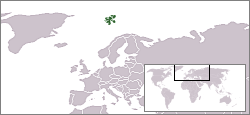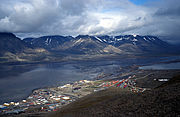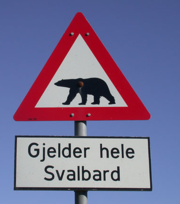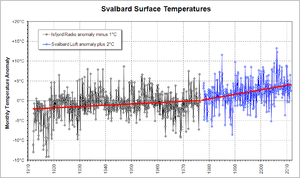
Svalbard
About this schools Wikipedia selection
SOS believes education gives a better chance in life to children in the developing world too. SOS Children works in 45 African countries; can you help a child in Africa?
| Svalbard Svalbard
|
||
|---|---|---|
|
|
||
| Capital and largest city |
Longyearbyen | |
| Official languages | Norwegian | |
| Government | Region of Norway | |
| - | Governor | Per Sefland |
| Area | ||
| - | Total | 61,022 km2 23,560 sq mi |
| Population | ||
| - | estimate | 2,321 (2007) |
| Currency | Norwegian krone ( NOK) |
|
| Time zone | CET ( UTC+1) ( CEST ( UTC+2)) | |
| Calling code | 47 | |
| Internet TLD | .no ( .sj allocated but not used) | |
Svalbard is an archipelago in the Arctic Ocean north of mainland Europe, about midway between Norway and the North Pole. It consists of a group of islands ranging from 74° to 81° North, and 10° to 35° East. The archipelago is the northernmost part of Norway. Three islands are populated: Spitsbergen, Bear Island and Hopen. The largest settlement is Longyearbyen. The Svalbard Treaty recognises Norwegian sovereignty over Svalbard and the 1925 Svalbard Act makes Svalbard a full part of the Norwegian Kingdom.
History
Norwegians or Icelanders may have discovered Svalbard as early as the 12th century. Traditional Norse accounts exist of a land known as Svalbarð - literally "cold shores". (But this land might also have been Jan Mayen, or a part of eastern Greenland.) The Dutchman Willem Barents made the first indisputable discovery of Svalbard in 1596. The islands served as an international whaling base in the 17th and 18th centuries, when the Greenland whale was extirpated from this region. From 1611 to the 1800s whaling took place off the western coast of Spitsbergen, by Basque, British, Danish, Dutch, French, and Norwegian ships. They also provided the headquarters for many Arctic exploration expeditions.
At the beginning of the 20th century, American, British, Swedish, Russian and Norwegian companies started coal mining. Norway's sovereignty was recognized by the Svalbard Treaty of 1920 with an addition that there would be limited military use of Svalbard and that the other nations retained the rights to their settlements; five years later Norway officially took over the territory. Some historians claim that Norway was given sovereignty as compensation for its Merchant Fleet losses during World War I, when the Norwegian Merchant fleet played an important role supplying the UK. Only Norwegian and Russian settlements survived World War II.
From the late 1940s to the early 1980s the geology of the Svalbard archipelago was investigated by teams from Cambridge University and other universities (e.g., Oxford University), led by Cambridge geologist W. Brian Harland. Many of the geographical features of the isles are named after the participants in these expeditions, or were given names by them linked to places in Cambridge (see Norwegian Polar Institute).
The name of the largest island in the archipelago, Spitsbergen (Dutch for "Jagged mountains") was formerly used to refer to the entire archipelago, while the main island was called West Spitsbergen.
Politics
Svalbard is completely controlled by the Kingdom of Norway and is part of it. The Svalbard Treaty recognizes Norwegian sovereignty over Svalbard. However Norway's power over Svalbard has some limitations in taxation, environmental conservation, non-discrimination and certain military activity.
Svalbard was made a part of Norway by a Norwegian act in 1925, thus Svalbard is not a Norwegian dependency. However, under the terms of the treaty, citizens of signatory states have rights to exploit mineral deposits and other natural resources "on a footing of absolute equality". As a result, a permanent Russian settlement, more or less autonomous, grew up at Barentsburg. Another Russian settlement at Pyramiden was abandoned in 2000.
According to Per Sefland, Norway's governor on the archipelago, the Svalbard Treaty of February 9, 1920 implies that "If you're able to find a job, you have the right according to the treaty to come here." The treaty states: "The nationals of all the high contracting parties [signatories] shall have equal liberty of access and entry for any reason or object whatever to the waters, fjords and ports of the territories." Therefore, some immigrants who have been denied residence in EU countries have relocated to Svalbard.
Seed Vault
The Norwegian government has built a " doomsday" seed bank to store seeds from as many of the world's crop varieties and their botanical wild relatives as possible. The bank was created by hollowing out a 120-meter tunnel on Spitsbergen cut into rock with a natural temperature of -6 degrees Celsius, refrigerating it to -18 degrees Celsius, and then storing seeds donated by the 1,400 crop repositories maintained by countries around the world. The vault has top security blast-proof doors and two airlocks. The number of seeds stored depends on the number of countries participating in the project. The point of this project is to prevent the diversity of agricultural crops currently stored (typically in the form of seed) in seed banks from becoming extinct as a result of accident, mismanagement, equipment failure, war or natural disaster, or due to a regional or global catastrophe, such as global warming.
Geography and nature

Svalbard consists of a group of islands in the Arctic Ocean ranging from 76° to 81° North and 10° to 35° East, and forms the northern-most part of Norway and the northern-most lands of Europe. The islands cover an area of 61,022 km², of which about 60% (36,502 km²) is covered by glaciation. Three large islands dominate: Spitsbergen (37,673 km² or 14,550 square miles), Nordaustlandet, (Northeast Land), (14,443 km² or 5576 square miles) and Edgeøya (Edge Island) (5074 km²or 1959 square miles) There is also the smaller Barentsøya (1,288 km²), Kvitøya (682 km²), Prins Karls Forland (English: Prince Charles Foreland) (615 km²), Kongsøya (191 km²), Bear Island (178 km²), Svenskøya (137 km²), Wilhelmøya (120 km²) and other smaller islands or skerries (621 km²).
At the night before 21 February 2008, Svalbard was hit by the strongest earthquake in recorded Norwegian history. The quake measured 6.2 on the Richters scale, and had its epicenter in Storfjorden, 140 km southeast of Longyearbyen ( ).
Svalbard lies far north of the Arctic Circle. In Longyearbyen, the midnight sun lasts from April 20 to August 26, and polar night lasts from October 26 to February 15. From November 12 to the end of January there is civil polar night, a continuous period without any twilight bright enough to permit outdoor activities in the absence of artificial light. The only other non- Inuit or research settlement that has this phenomenon is Dikson near the mouth of the Yenisey River in Russia.
In addition to humans, four predominantly terrestrial mammalian species inhabit the archipelago: the Svalbard field mouse Microtus epiroticus, the Arctic fox, the Svalbard reindeer (a distinct sub-species), and polar bears. Since polar bears occur very commonly on Svalbard and are known to hunt humans on occasion, all people need to take precautions when outside the settlements: this includes carrying a rifle. Nevertheless, the law protects polar bears, forbidding anyone to harm or disturb them unless it is necessary to remove a considerable danger of injury to a person. A large number of aquatic mammalian species also inhabit the archipelago, including whales, dolphins, seals and walruses.
Svalbard is also a breeding ground for large numbers of seabirds, including Brunnich's and Black Guillemot, Puffin, Little Auk, Fulmar and Black-legged Kittiwake. Other seabirds include Arctic Tern, four species of skua, and the elusive Ivory Gull. The Svalbard Ptarmigan, found on the larger islands, is the only land bird present for the entire year. Only two songbirds migrate to Svalbard to breed: the Snow Bunting and the Wheatear.
There is an astonishing variety of flowering plants on Svalbard. Although they are very small, these plants use the short period of 24-hour daylight to produce colourful blossoms. See also: Flowers of Svalbard.
Millions of years ago, Svalbard experienced much warmer climates and was forested, even though it was located at around the same latitude as at present. For a phase of several hundred thousand years at the boundary between the Paleocene and Eocene (55 million years ago), Svalbard experienced subtropical temperatures with palms and alligators. Although not generally as warm as this, Svalbard remained mild enough temperatures for forest through most of the Cretaceous and early Tertiary period up until at least 30 million years ago. In February 2008, the University of Oslo announced the discovery of the largest dinosaur-era marine reptile ever found - a pliosaur estimated to be almost 15 m (50 ft) long ( Pliosaur discovered - Science daily).
Svalbard is part of the High Arctic Large Igneous Province.
Fjords
There are numerous fjords among the Svalbard islands; the five longest of which (measured from the head to open sea) are listed here:
- Wijdefjorden, 108 km
- Isfjorden (Svalbard), 107 km
- Van Mijenfjorden, 83 km
- Woodfjorden, 64 km
- Wahlenbergfjorden, 46 km
Coastlines
Coastlines of the Svalbard islands (listed from largest island to smallest) show the extensive variability characteristic of glacial formation:
- Spitsbergen, 3,919 km
- Nordaustlandet, 1,688 km
- Edgeøya, 502 km
- Barentsøya, 205 km
- Kvitøya, 119 km
- Prins Karls Forland (Eng. Prince Charles Foreland), 320 km
- Kongsøya, 132 km
- Bear Island (Bjørnøya), 88 km
- Svenskøya, 62 km
- Wilhelmøya, 58 km
- Other smaller islands and skerries, 1,736 km
Mountains
Although small when compared with the mountains of Norway, the elevation of the Svalbard island mountains accounts for much of the glacial erosion:
- Newtontoppen, 1713 m
- Perriertoppen, 1712 m
- Ceresfjellet, 1675 m
- Chadwickryggen, 1640 m
- Galileotoppen, 1637 m
Glaciers
- Austfonna (with Sørfonna and Vegafonna) 8.492 km²
- Olav V Land 4.150 km²
- Vestfonna 2.505 km²
- Åsgårdfonna 1.645 km²
- Edgeøyjøkulen 1.300 km²
- Hinlopenbreen 1.248 km²
- Negribreen 1.182 km²
- Bråsvellbreen 1.160 km²
- Etonbreen 1.070 km²
- Leighbreen 925 km²
- Holtedahlfonna (with Isachsenfonna) 900 km²
- Kvitøyjøkulen ( Kvitøya (island)) 705 km²
- Stonebreen 700 km²
- Kronebreen 700 km²
- Hochstetterbreen 581 km²
- Barentsjøkulen 571 km²
- Balderfonna 543 km²
- Nathorstbreen 489 km²
- Monacobreen 408 km²
Settlements
Inhabited
- Barentsburg (Баренцбург) (Russian settlement — population of 850)
- Bear Island (Norwegian weather station, population of 9)
- Hopen (Norwegian weather station, population of 4)
- Hornsund (Polish research station, population of 8)
- Isfjord radio
- Longyearbyen (population of 1,800)
- Ny-Ålesund (population of 40)
- Pyramiden (Пирамида) (Russian settlement, abandoned in 2000)
- Sveagruva (population of 210)
No roads link the settlements on the island; transportation includes boat, plane, helicopter, and snowmobile. The gateway to Svalbard is through Svalbard Airport, Longyearbyen.
Former
- Cookery of Harlingen (Dutch settlement established in 1636 in Houcker Bay or Virgohamna, probably abandoned mid-century)
- Engelskbukta (English settlement established around 1615, occupied until mid-century)
- Gravneset (English settlement from 1614 to 1624 or 1625, after which time it was appropriated by the Dutch)
- Grumantbyen (Грумант) (Russian settlement, abandoned in 1961, revival of mining operations announced in 2003)
- Gåshamna (Two English settlements, established sometime around 1618 and occupied until at least 1655)
- Lægerneset (Dutch settlement appropriated by the English in 1615, occupied by the latter until the 1650s)
- Kobbefjorden, Danskøya (Danish settlement established in 1632, probably abandoned around mid-century)
- Port Louis or Rekvedbukta (French settlement established in 1633, most likely abandoned only a few years later)
- Smeerenburg (Dutch settlement established in 1617 on the southeastern promontory of Amsterdam Island, abandoned around 1660)
- Ytre Norskøya (Dutch settlement possibly rivaling Smeerenburg in size; probably established by members of the Zeeland chamber in 1617)
Climate
The North Atlantic Current moderates Svalbard's Arctic climate, keeping the surrounding waters open and navigable most of the year. The average Summer temperature is around 5 degrees Celsius (°C), or 41 degrees Fahrenheit, and in winter, −12 °C (10 F). The Western coast is considerably warmer and wetter than the east, due to the North Atlantic Drift. The interior fjord areas and valleys, sheltered by the mountains, have the warmest summers (July 24-hr average of 6.5°C in Longyearbyen) and little precipitation.
Due to its history of human occupation, Svalbard has one of the longest high-latitude meteorological records on earth. Computer models of global climate have long predicted enhanced greenhouse warming at such latitudes, so the Svalbard record is of particular interest. It shows an approximate 6 °C increase in 100 years; with 4 °C increase in the last 30 years.
Economy
Economic activity centres on coal mining, supplemented by fishing and trapping. In the final decades of the 20th century, tourism, research, higher education, and some high-tech enterprises like satellite relay-stations grew significantly. A 200 nautical mile (370 km) Fisheries Protection Zone around Svalbard was established in 1977 pursuant to the Act of 17 December 1976 relating to the Economic Zone of Norway. Despite recent discussions, Russia and Norway dispute their maritime limits in the Barents Sea and Russia's fishing rights beyond Svalbard's territorial limits within the Svalbard Treaty zone.
The Svalbard Undersea Cable System which started operation in January 2004 provides dual 1440 km fibre optic lines from Svalbard to Harstad via Andøy, needed for communicating with polar orbiting satellite stations on Svalbard, some owned by the National Aeronautics and Space Administration (NASA) and the National Oceanic and Atmospheric Administration (NOAA), both United States government agencies.
The Norwegian state-owned coal company employs nearly 60% of the island's Norwegian population, runs many of the local services, and provides most of the local infrastructure. Coal production has increased significantly over the past 10 years, rising from less than 500,000 tons in 1994 to over 2,500,000 tons in 2004.
Exploration for oil and natural gas is underway.
Coal mining in Svalbard
The Ny Ålesund mine was closed down in 1963 after an explosion in 1962 when 21 lives were lost, and has since been converted to a scientific post.
As of 2006, there are three operational coal mines in Svalbard. There are large mines in Sveagruva (production 2 million tonnes per year, and Barentsburg, while the small mine in Longyearbyen is used mainly to supply the town's own power plant.
Demographics
Svalbard has a population of approximately 2,400 people as of 2005. Approximately 70% of the people are Norwegian; the remaining 30% are Russian, Ukrainian and Polish. The official language of Svalbard is Norwegian. Russian is used in the Russian settlements, but formerly, Russenorsk was the lingua franca of the entire Barents Sea region. The annual population growth is -0.02%
|
||||||||||||||
Education
The University Centre in Svalbard (UNIS), established in 1993, is the world’s northernmost higher education institution. Located in Longyearbyen at 78º N, the university offers undergraduate, graduate and postgraduate courses to approximately 350 students each year in Arctic sciences.
Northernmosts in Svalbard
Svalbard contains the northernmost instance of several institutions - including the world's northernmost school, church, hospital, bank, airport, newspaper and movie theatre.
Svalbard in popular culture
- Svalbard is featured as the setting for much action in Philip Pullman's His Dark Materials trilogy. A gateway was created there from which one could gain access to parallel universes. The Svalbard in the books is inhabited by a race of intelligent armored polar bears ( Panserbjørne), ruled by Iofur Raknison (as of the first book). Svalbard was featured in the 2007 film adaptation of the first book in the series, The Golden Compass, as the "Kingdom of the Ice Bears".
- The popular 1985 Norwegian film Orion's Belt takes place on Svalbard.
- The Captain of the Polestar by Sir Arthur Conan Doyle is set off Amsterdam Island at the North West of Svalbard.
- Most of the action in The Chronicles of William Bazillion takes place on Svalbard, in the present and in the past.









